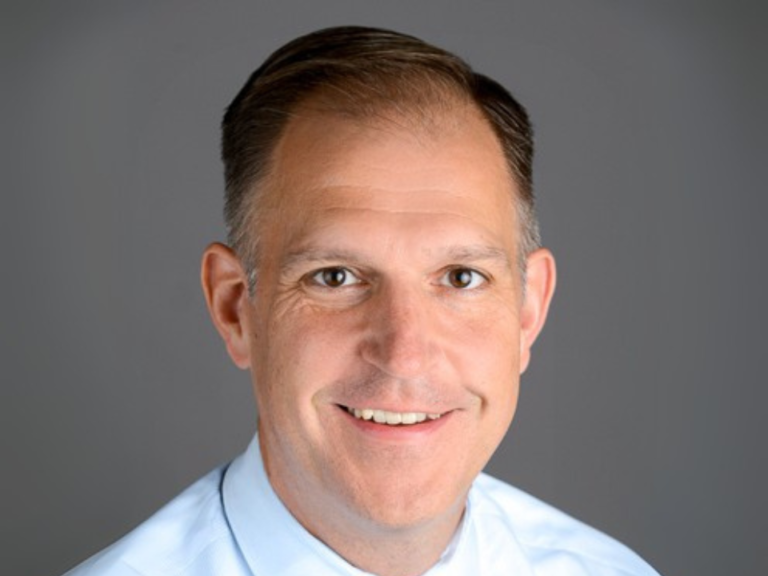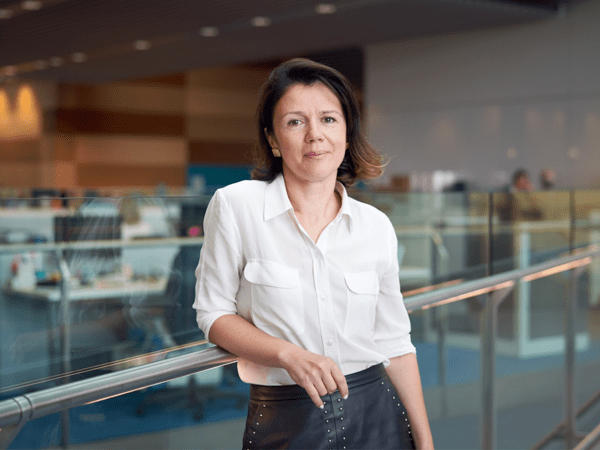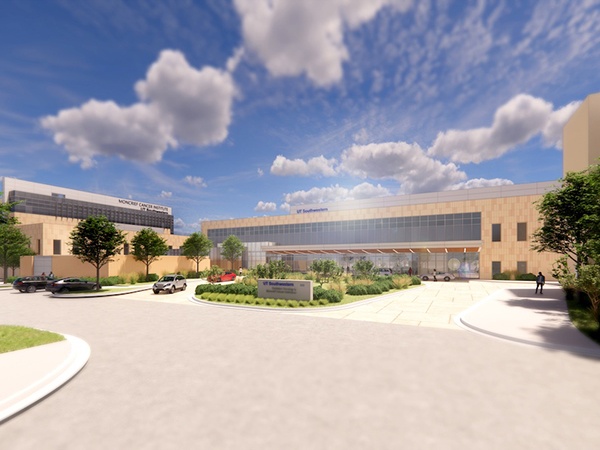City of Hope has received a $50 million gift for a 190,000-square-foot outpatient center in Irvine, Calif.
As a result of the gift, from Lennar Foundation, an offshoot of a building company, the facility, which is slated to be opened in 2022, will be named Lennar Foundation Cancer Center at City of Hope Orange County.
City of Hope is investing $1 billion to develop an 11-acre campus at the Orange County FivePoint Gateway in Irvine, Calif. Separately, a new City of Hope specialty hospital on the Orange County campus is expected to open in 2025 (The Cancer Letter, Jan. 29, 2021; June 28, 2019)
In a conversation with The Cancer Letter, Robert Stone, president and chief executive officer of City of Hope and Helen and Morgan Chu Chief Executive Officer Distinguished Chair, said the strategy City of Hope is using in developing its Orange County campus and network of cancer care is designed to have impact on a national scale.
“In my view, NCI-designated centers have an opportunity to increase their impact in the community,” Stone said.
“We are creating a model of care and partnering with community providers, as well as non-traditional partners, to elevate the care in those communities. That’s what this gift [from Lennar Foundation] is going to allow us to do in Orange County. We’re taking that model and combining it with other strategies, like AccessHope, which is our direct-to-employer outreach, to create a system that increases patient access to potentially life-saving care.
“You will see us continue to grow our impact and national reach.”
The Lennar Foundation Cancer Center will house an outpatient cancer center opening in 2022 that will offer specialized cancer care, phase I through phase III clinical trials, precision medicine, and early detection and prevention programs.
Lennar Foundation is a charitable arm of homebuilder Lennar Corp., a Miami-based publicly traded company. The gift, which was announced March 31st, is the largest single philanthropic contribution to City of Hope Orange County.
A portion of the Lennar gift to City of Hope will support collaborative translational research between City of Hope and the Sylvester Comprehensive Cancer Center of the University of Miami. Both City of Hope and Sylvester serve diverse populations, and both have received investments from Lennar in the past.
“This gift will enable collaborative, translational science that will drive innovation and catalyze timely and necessary progress towards health equity,” said Stone.
When the Orange County expansion project is completed, City of Hope will operate two academic cancer campuses in its four-county primary service area. The other academic cancer center in Orange County, the Chao Family Comprehensive Cancer Center, is a part of UC Irvine. NCI designated academic cancer centers in greater Los Angeles area include UCLA Jonsson Comprehensive Cancer Center and USC Norris Comprehensive Cancer Center.
Materials related to the history of City of Hope are posted here, on the Cancer History Project.
Stone spoke with Paul Goldberg, editor and publisher of The Cancer Letter.
Paul Goldberg: Thank you for talking with me. So, you got a $50 million gift.
Robert Stone: We did. It’s a $50 million gift to City of Hope to advance the comprehensive cancer campus and network of care in Orange County.


The Lennar Foundation gift is going to allow us to accelerate phase I through phase III clinical trials, to enable a consumer-facing prevention strategy, and will help further develop a model that I think is unique among cancer centers.
Orange County is the sixth largest county in the country, and about 20% of the people who need advanced cancer care leave the county to get treated.
So, we’re going to build a second City of Hope campus in the Great Park that will allow us to be embedded in the community to make it easier for Orange County residents to get world class cancer treatment.
In my view, NCI-designated centers have an opportunity to increase their impact in the community.
We are creating a model of care and partnering with community providers in a unique manner that elevates the care in those communities. That’s what this gift [from Lennar Foundation] is going to allow us to do in Orange County.
As we build a novel and differentiated approach to cancer care, we’re taking that model and combining it with some other things we’re doing to improve outcomes also aimed at elevating oncology care across the country, like AccessHope, which is our direct-to-employer strategy.
You’ll see us continue to bring innovative approaches into areas where there is a need, with the next iteration likely being outside of Southern California.
Oh, really? What are you going to do?
RS: Well, in many ways we already have expanded outside of the state.
For example, we launched AccessHope in 2019, a wholly owned subsidiary dedicated to serving employers and supporting their existing health care partners. Cancer is often a top diagnostic category, and historically drives 12-14% of an employer’s total medical cost.
By the end of the year, I expect AccessHope will support about three million members employed by approximately 50 national employers headquartered in more than 20 states. The primary purpose is to enable patients to receive the right diagnosis and the best care plans at the right time.
What is unique is that our mission is not based on the travel to the center-of-excellence model, but rather we are seeking to democratize cancer care in partnership with employers. In other words, people do not always have to fly to Southern California or to another NCI-designated center for access to the best specialists.
So, you may see us expand by supporting the existing infrastructure in different geographies; you may see us find organizations in other geographies that provide great cancer care, and want a partnership with an NCI-designated academic center; or you may see us put up bricks and mortar in other states where we think there’s a gap to fill.
The point is that you’re going to find some health care providers are going to struggle post-COVID, and what makes City of Hope unique, as opposed to a cancer center embedded in a university or health system, is that the entire organization is able to make decisions quickly, and act quickly, solely focused on the needs of cancer patients.
That focus allows us try new strategies and be disruptive.
How does that connect with the $50 million gift? Does it connect?
RS: It connects in a couple of ways. People in our country need renewal, and for people working at City of Hope renewal comes from the intersection of finding joy in your work, connecting to the mission, and making progress.
And so, at a time when many places are hunkering down, this gift allows us to continue moving forward; it accelerates impact and growth; and it allows us to continue recruiting physicians and scientists who have dedicated their lives to eradicating cancer.
I also think that we tend to be siloed as an industry. We talk about partnerships, but partnerships often reside between similar organizations. Far too often, we don’t look at things as an industry through a broader lens, and this is something that City of Hope is doing.
Take the Great Park, for example. We originally decided to build our new cancer center in Irvine, because we found an innovative developer, FivePoint chairman of the board and CEO, Emile Haddad, who was building a new community from the ground up based on wellness and healthy living. Partnering with FivePoint and being embedded in the community from the beginning creates synergies that allow us to innovate and develop new strategies that we might not have thought of otherwise. And Lennar’s generosity allows us to bring those innovations to practical benefit more quickly.
Another example of how the gift enables new partnerships is that Lennar Foundation, which made the $50 million donation to us, also has a longstanding relationship with Sylvester, in Miami, and has brought us together with an idea of finding new solutions that address health disparities in cancer, using data from diverse populations.
Think of Southern California; our primary service area is incredibly diverse. So is Miami.
And finally, the gift allows us to continue developing the whole model of combining highly sophisticated subspecialty, research-driven care with care that’s delivered in the community, to elevate both. This gift allows us to do all of those things.
If I were to start thinking of potential research partners, or business partners, for City of Hope, just for geographical reasons, I wouldn’t have thought of Sylvester. It’s a wonderful place, well run, full of smart people, but there’s a lot of America between City of Hope and Sylvester.
RS: You’re right, there is a lot of ground between us and Miami, but you’ll start seeing those gaps filled in. We, like every other major cancer center, have research partnerships not just across the country, but across the globe.
It is not easy being a good partner, and not all organizations are able to be one. We have a differentiated approach to partnerships and are committed to be a partner of choice for organizations across different sectors, collaborating in both traditional and novel ways to advance our mission of eliminating cancer and delivering the cures of tomorrow to the people who need them today.
For example, we’ve recently announced Northwestern Medicine is the first foundational partner in AccessHope, and you can start seeing geographic reach across the country that we will be able to make together.
We have long partnered with biotech companies to license our discoveries and speed their clinical development.
We are also building on our strong foundation in philanthropy to provide a vital source of funding for us to invest in breakthrough research and improved clinical care models. Early this year we announced a $100 million donation from Dr. Arthur Riggs, one of our most distinguished scientists, in support of our research as well as this recent gift from Lennar Corp.
What precisely are you doing with Sylvester? Is it outreach and engagement?
RS: Well, I agree with you the Sylvester is a wonderful place, well run and full of smart people.
As you would imagine, our respective physicians and scientists have long-standing professional relationships. We are excited about Lennar making this connection on an organizational level and staying close.
What specifically we’re doing here is a combined research project centering around data and precision medicine of the diverse populations of Southern California and the diverse populations of Miami.
It’s a research collaboration today and we’ll see where it goes from there. The potential is boundless.
What you’re saying is it’s possible that you might see a City of Hope sign pop up almost anywhere in America?
RS: Well, you can see City of Hope’s influence pop up anywhere in America. We’ve been working on this now for years.
One of the first things we did was start building a clinical network away from the main campus in Duarte throughout Southern California. We now have more than 30 clinical sites. We did that for two reasons. One is a belief that when appropriate, you should take care of patients where they are, so that patients and their families don’t have to drive long hours in LA traffic if they don’t need to.
A second and very important reason was about creating an ecosystem in which patients could seamlessly flow between appropriate sites of care. Bridging care and coordinating across 30 different locations with an academic cancer center that’s grown to over a 1,000 physicians and scientists is an ongoing journey. It takes expertise we have been developing over many years.
How is your plan different from MD Anderson’s?
RS: I have a lot of respect for Anderson, and they would be better positioned to give you an overview of their network. I’d rather spend a few minutes explaining what our plan is and why we think it is unique.
Our experience in AccessHope, our 30-plus site Southern California network, our second academic campus in Orange County—those three data points—have allowed us to create and operate multiple models to service patients.
Traditional models of expansion have too often gone to one of two extremes. One extreme is you’re a bricks and mortar model, where your doctors provide care at every location. Another model is to provide community practitioners with protocols and leave it to them to follow to the best of their ability.
What we’re doing is taking multiple approaches to delivering leading edge care and research to patients everywhere; a large traditional academic center that anchors an integrated community network; a new campus for a community that needs the services; and remote care options through a new model such as AccessHope that brings subspecialty expertise to patients and community oncologists anywhere.
Given that 80% of cancer patients in the country are not treated at an academic center, and the speed at which new discoveries are changing optimal care, we felt obligated to develop multiple models to support both patients and our oncology colleagues so, when needed, everyone can have access to the most current information that will drive best outcomes.
This is a model that we have been working on now for a number of years, partnering both with traditional providers and non-traditional partners to provide a better patient care experience closer to home.
How do you monetize that?
RS: We’ve been blessed by robust philanthropic investments and returns from our research. The monetization is, of course, relevant, I don’t want to pretend it’s not, but it’s a secondary issue. The first question for us is where can we fill a gap?
I’m deeply concerned about the adverse impact to cancer patients caused by restricted patient access to leading cancer centers, where the most leading-edge diagnostics and advanced, life-saving therapeutics are available. I’ve had the experience, we all have, where somebody I’ve known for years called me up and said, “I don’t want to bother you, but I was diagnosed with cancer, I went to my doctor and they said I should see a specialist and the specialist is available in 45 days. Do you think that’s too long for me to wait?” Yes, it absolutely is.
Academic centers should not be pulling patients out of the community and taking things to the more expensive academic center if it can be done safely in the community.
But, by the same token, we must have a model that allows for patients in need of complex care to receive that care in the appropriate setting with the right experience and expertise, and the model should support important translational research so humanity will benefit from discoveries that will lead to more affordable care and better outcomes in the future.
The fusion of academic oncology and community oncology is probably the biggest story out there. It seems to be in a bit of a pause because of COVID. At least I haven’t had a chance to look at it in a dedicated fashion in recent months.
RS: I think that those market dynamics are happening, at least in Southern California, and what you’re seeing is a significant consolidation of the community practices, but people haven’t figured out what does that mean for care. Our aim is to ensure the model shifts in a way that puts patient needs at the center.
That’s what is driving our network model and our entry into Orange County. City of Hope is investing a billion dollars for a second academic campus, so that we can take academic care into the community.
One of the reasons others have not done is because no one has completely figured out how do you make it work from a practical standpoint. And while we don’t think we have all the answers, we’ve gotten ourselves more than comfortable that we’ve got enough of the answers that we’ll be able to make it work well and provide great benefit to the patients and families we serve there.
I wasn’t actually talking about the tensions between these two entities, academic and community, I was talking more about the fusion of those entities. Because they’re starting to look more like you, and you are starting to think a lot like them as well. So, the point of convergence is not necessarily in the middle, but somewhere on the continuum; no?
RS: I don’t think we want a fusion; that is one of the problems in health care; we are too quick to look for one-size fits all solutions.
Community oncologists play a very important role in the future of cancer care. They take care of all types of cancer, see high volumes and are able to serve the patient and family in the community, close to their support system.
And they do so efficiently in most cases. Academic medicine should also strive for efficiency but is needed to address the complex and the future, focusing on discovery, translational research, multi-disciplinary care for the more complex cases, performing complex operations and serving to accelerate the learnings from progress, (e.g. Precision Medicine), into the mainstream.
We are not aspiring to fuse the two practices, but rather to seamlessly integrate them into one ecosystem that has the patient and family needs at the center.
Great. Thank you so much.












